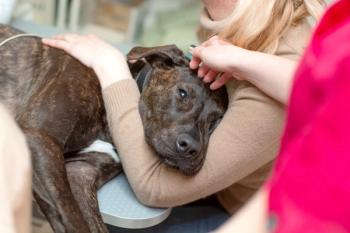
Veterinary Surgeons Replace Canine Skull with 3D-Printed Plate
A pair of veterinary surgeons used 3D-printing technology to replace 70% of a dog’s skull after removing a cancerous tumor.
Veterinary surgeons from the University of Guelph's Ontario Veterinary College and the Cornell University College of Veterinary Medicine are celebrating what they are calling a major advancement in veterinary medicine. Using 3D printing technology, the surgeons were able to successfully replace a large portion of a dog’s cancer-ridden skull with a custom titanium plate. The surgery is believed to be the first of its kind in North America.
The procedure was performed on a 9-year-old dachshund named Patches that presented at Cornell under the care of Galina Hayes, BVSc, MRCVS, PhD. Patches had been diagnosed with a multilobular osteochondrosarcoma that had grown so large that it was weighing down her head and growing into the dog’s skull, coming dangerously close to her brain and eye socket. Upon examination, it was confirmed that due to the progress of the mass, Patches would need 70% of her skull removed, leaving a large area of the brain unprotected. Typically for a case of this kind, the predetermined region of the dog’s skull would be surgically removed and replaced during surgery with titanium mesh.
RELATED:
- 3-Dimensional Printing in Veterinary Medicine
- New Augmented Reality Program Teaches Canine Anatomy
Rather than using that method for such a large portion of the dog’s skull, Dr. Hayes consulted with Michelle Oblak, DVM, DVSc, her former colleague at Ontario Veterinary College, who has been studying the use of digital rapid prototyping in advance planning for surgeries, and 3D printed implants for reconstruction. Together, the pair were able to successfully perform the procedure.
“The technology has grown so quickly,” said Dr. Oblak, “and to be able to offer this incredible, customized, state-of-the-art plate in one of our canine patients was really amazing.”
Prior to surgery, Dr. Oblak mapped the tumor’s size and location and then worked with engineers to create a 3D model of Patches’ head and tumor. This provided her with the ability to perform a mock version of the surgery in advance to best determine what areas of the dog’s skull would remain intact after the tumor was removed. “I was able to do the surgery before I even walked into the operating room,” Dr. Oblak said.
Once she was confident in the portion of the skull that needed to be replaced, Dr. Oblak enlisted the help of ADEISS, a 3D medical printing company in London, Ontario, to adapt software the company normally used for human medicine. The printed plate fit into place perfectly during Patches’ surgery. Because the surgeons were able to use the preconstructed plate as opposed to titanium mesh, the surgery time was drastically decreased. Dr. Oblak told University of Guelph’s online journal that using the 3D printed pieces in advance of the surgery further eliminated the need to model an implant in the operating room. This, in turn, reduced patient risk by shortening the time spent under anesthesia.
“In human medicine, there is a lag in use of the available technology while regulations catch up,” she explained. “By performing these procedures in our animal patients, we can provide valuable information that can be used to show the value and safety of these implants for humans.”
Newsletter
From exam room tips to practice management insights, get trusted veterinary news delivered straight to your inbox—subscribe to dvm360.




